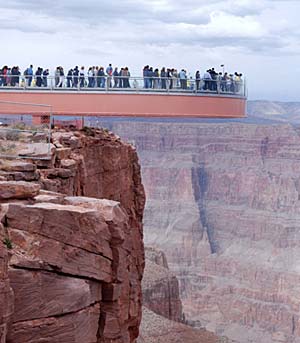While camera-toting tourists are able to access much of the Grand Canyon, the West Rim, mostly occupied by the Hualapai Indian Reservation, remains desolate. Dirt roads are the primary transportation route here, and only a few structures dot the landscape.


The Hualapai, along with Las Vegas developer David Jin and architect Mark Johnson, are hoping to change this—and improve the tribe’s struggling economy—with the Grand Canyon Skywalk. This 70-foot-long, glass-bottomed walkway cantilevers over the ravine’s edge, giving visitors a clear view 4,000 feet down to the canyon floor.
“It’s like nothing you could even imagine,” says Johnson, who first set foot onto the Skywalk at its unveiling on March 20. “I’m sure I’ll never work on anything like this again in my career.”
The viewing platform projects over a relatively narrow side canyon known as Eagle Point, named for a large rock formation that resembles a raptor with outstretched wings. Two large box beams, composed of 21 welded pieces, form the horseshoe-shaped structure; huge steel caissons, attached to piles drilled 40 feet into thick limestone, anchor them. Johnson says its shape was developed to maximize visitors’ perception of the dramatic surroundings—and the sensation that they are floating over the canyon.
The walkway measures 10 feet wide. Its transparent portions are made of five, three-inch-wide structural glass layers, each strengthened with an adhesive interlayer. The glass can support a live load of roughly 100 pounds-per-square-foot, or 800 people, but no more than 120 people will be allowed on it at a time. The entire Skywalk weights more than 1 million pounds.
Construction on the walkway began in 2005 and it was rolled into place earlier this year. Regular admission price is a steep $25 per visitor—and that’s not counting a $50 fee to enter the Hualupai reservation. Jin will split revenue from the project with the tribe, but he himself fronted most of the $30 million to construct the walkway.
Critics say that the walkway disrupts the canyon’s natural landscape, while some tribal elders express concern that it ruins sacred ground. Johnson responds that the Skywalk “doesn’t detract at all,” adding that it is barely noticeable compared to the massive size of the canyon itself.
But new criticisms have emerged in the month since the attraction opened. Some visitors have expressed disappointment that the Skywalk’s view is less expansive than anticipated; others balk at the high cost of accessing the walkway and the dearth of amenities including bathrooms.
“There will always be critics, but we’ve tried,” Johnson says. Moreover, the tribe is working to address some of the problems. Future project phases include a 27,000-square-foot museum, restaurant, visitor center, and event space located above the walkway’s cliff-side elements. Its design, Johnson says, mimics the site’s geographic formations, with a facade clad in sculpted concrete panels to match rock faces.
Nearby, the tribe is developing a re-created Indian village, which they hope will be another tourism draw. “This is going to be their future. You feel a personal tie to that,” Johnson says. “We’ve been fortunate to be here since it started. I guess sometimes you just luck out.”




Post a comment to this article
Report Abusive Comment